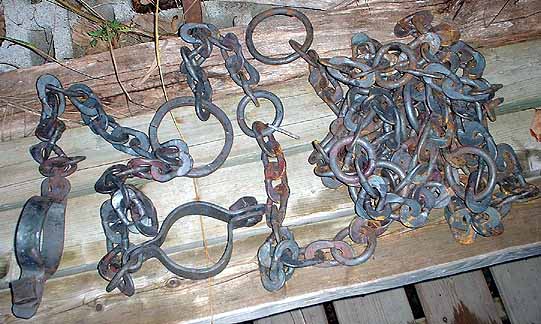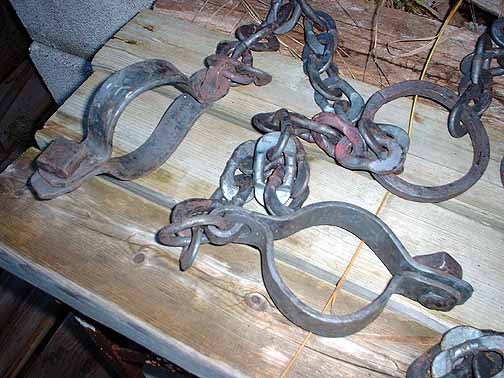First off, I am not aware of an artifact sample from the Viking Age that could be specifically identified as a prisoner or slave chain. There are a number of lengths of chain - but most commonly these are related to the cooking fire. Cauldron hangers and chain trammels of several types are found from the Viking Age. These range from simple circular or 'figure 8' shaped loops (just pinch the middle of a circle) to extremely elaborate elements found in royal quality burials.

For this project, the twin factors of design and cost would work directly against each other. The ideal approach would be to hand form and then forge weld each individual link. I would normally charge $5 per link for this work. You can see that the cost of 20 feet (roughly 200 links) would be very high! On top of that there was a time constraint to consider - ALL the work for this project was to be delivered for Oct 1.
In the end I proposed taking a heavy weight commercial chain and re-forging all the links to dress them to a hand worked look. This was considerably less labour than creating each link from scratch. I cut the chain into short one foot lengths, allowing for considerably easier handling of the hot and flexible chain. The end of each link was flattened - specifically in a random and irregular fashion. The short lengths were then joined back together using a roughly 3 inch diameter round link of 3/8 round.
One extra thing I did was quench the completed chain from a bright orange heat. Although basically a mild steel material, this quenching served to slightly harden the metal. The reason for this was sound. The completed chain makes a wonderful tinkling noise as it is dragged around!

The two terminal ends finished up in a much larger (roughly 4 inch) ring. At one end this was made from 3/8 square stock - this was the end the shackles were attached to.
The two shackles were attached to a separate two foot length that fitted through the terminal ring, allowing for free motion. The shackles themselves are formed of two pieces of heavy flat stock. Each pair of U shaped pieces ends in the same kind of loop and tab arrangement seen on sea chest hinges. Here the tab of the loop is made over long to allow for a small ring that attaches the chain. The end of the tab is welded back down to the cuff.
On the other end are punched a pair of matching holes. Through these is the locking pin. Historically this would be done by inserting and hammering over a rivet. Actors however, and not likely to submit to imprisonment (as much as the director might want to nail them down!) I had to design some system that would maintain the visual feel of the Viking Age - but also allow for quick application and removal. In the end I found a type of blind fastener the ideal size - thats a tube shaped bolt with the threads on the INSIDE. To each of these was welded a roughly square chunk of metal hot cut from heavy stock to give the appearance of a square head rivet. I created two different types of matching bolts. - one round headed and one square headed. These take about 30 seconds to screw in place to secure each shackle.
No comments:
Post a Comment